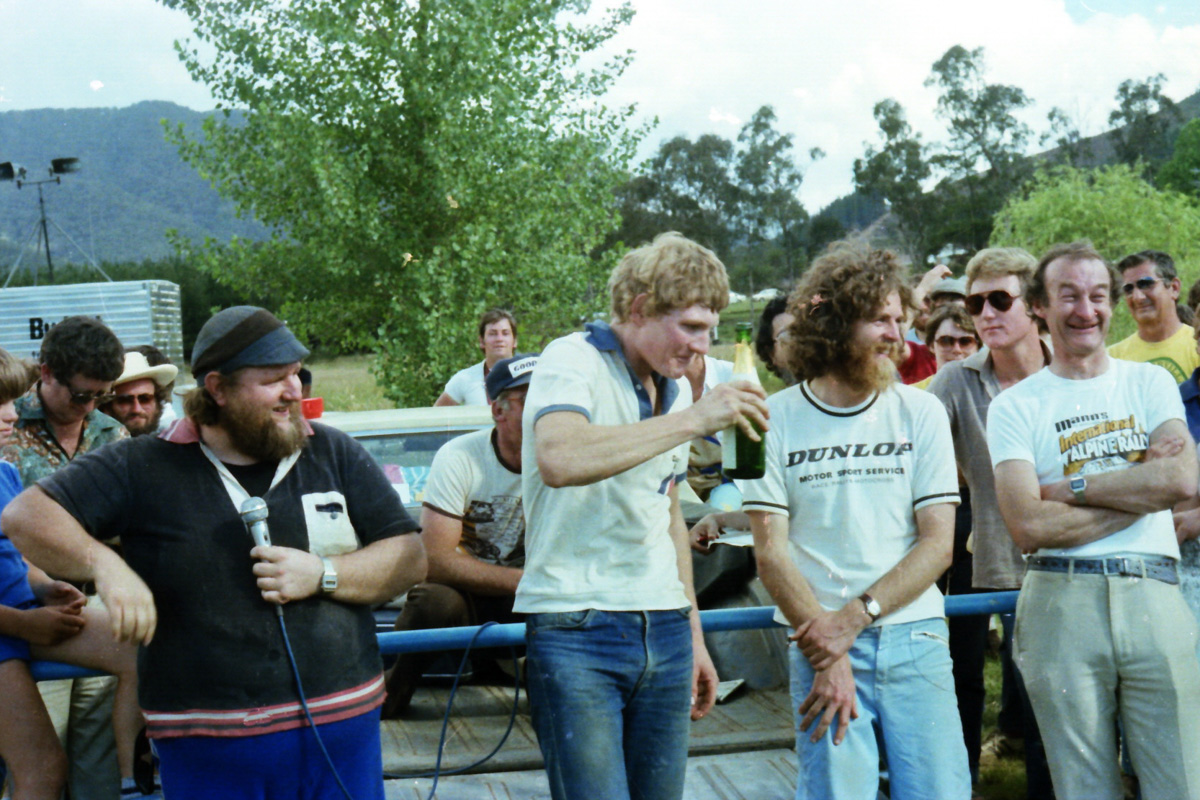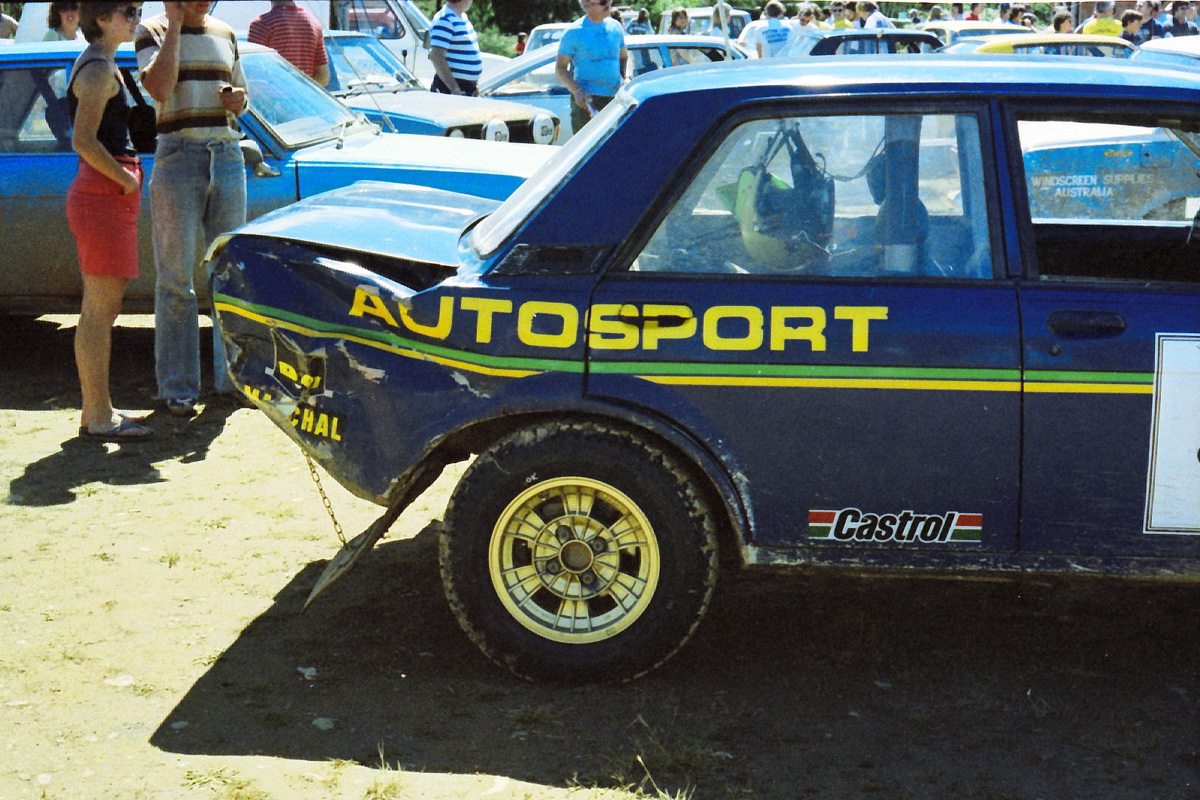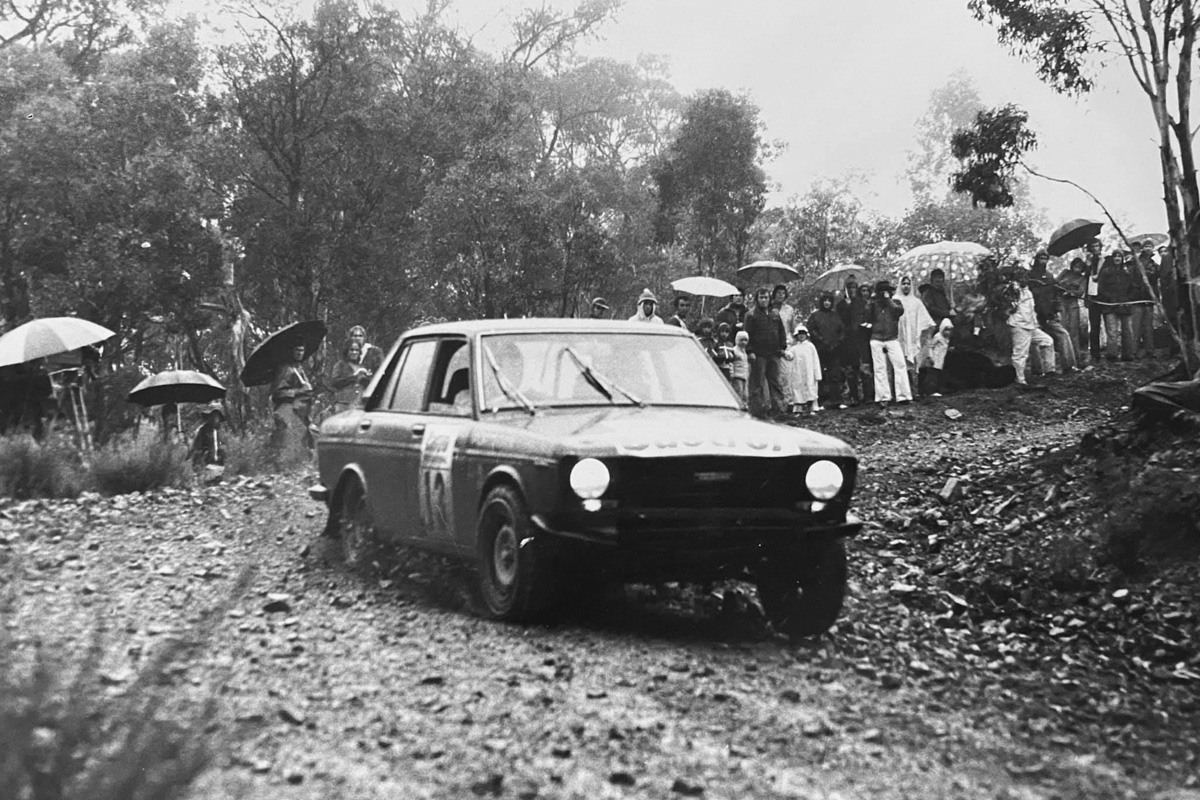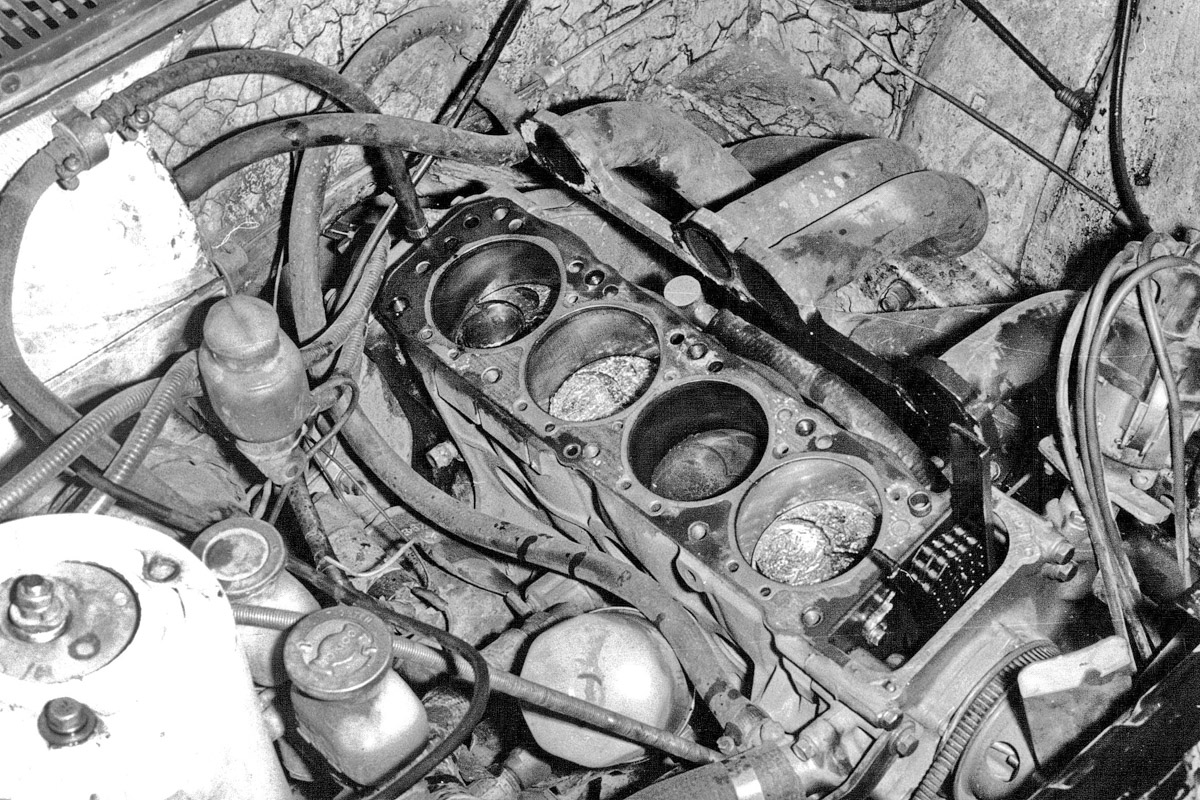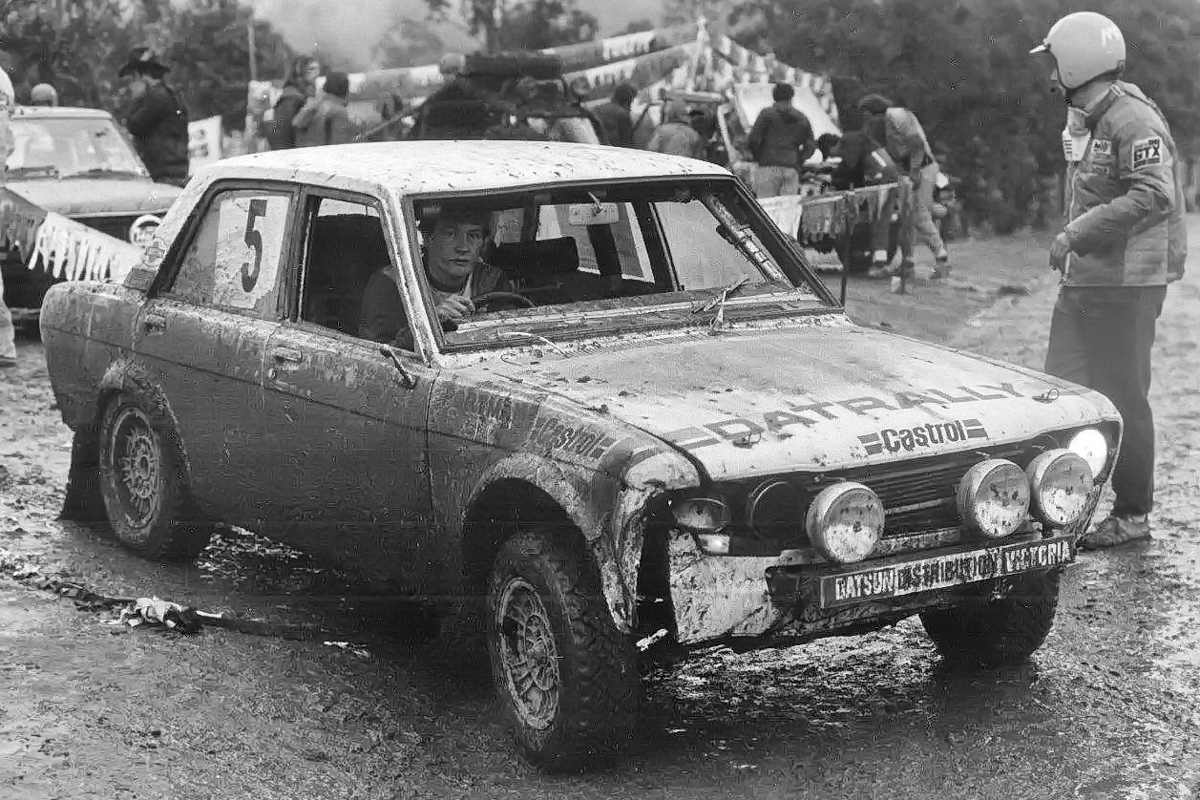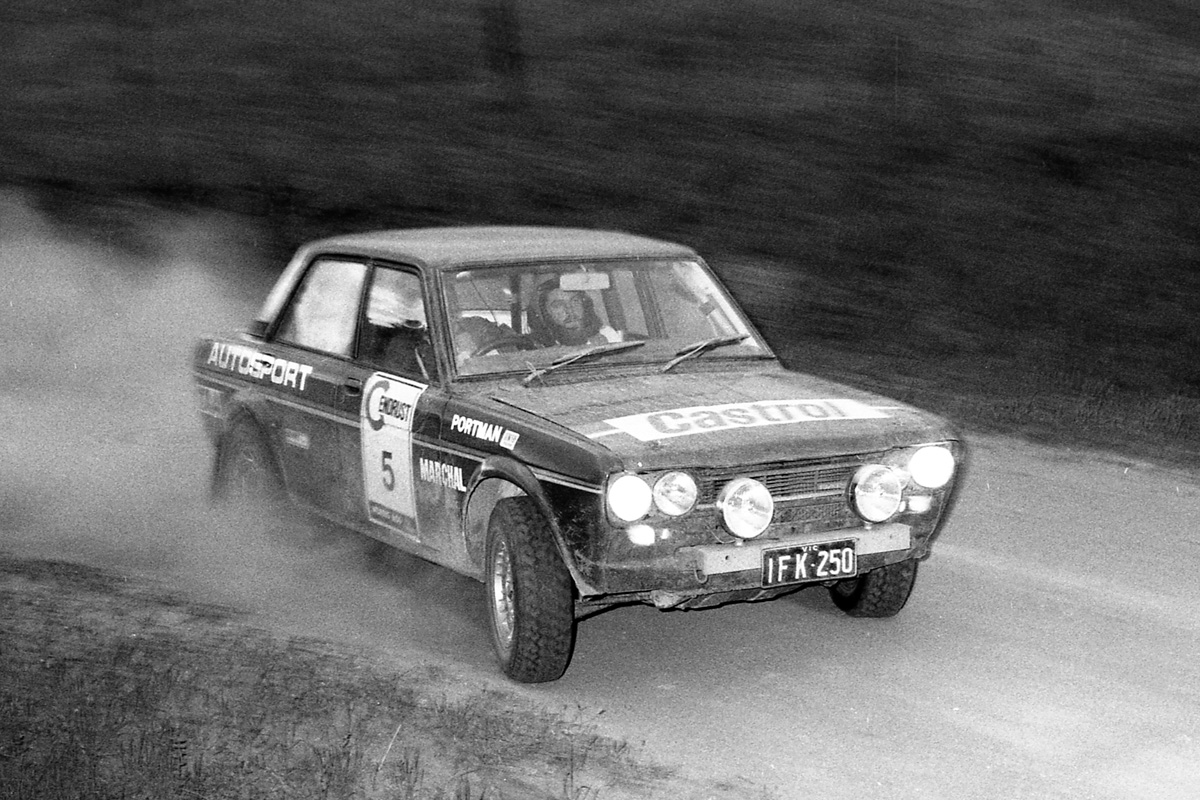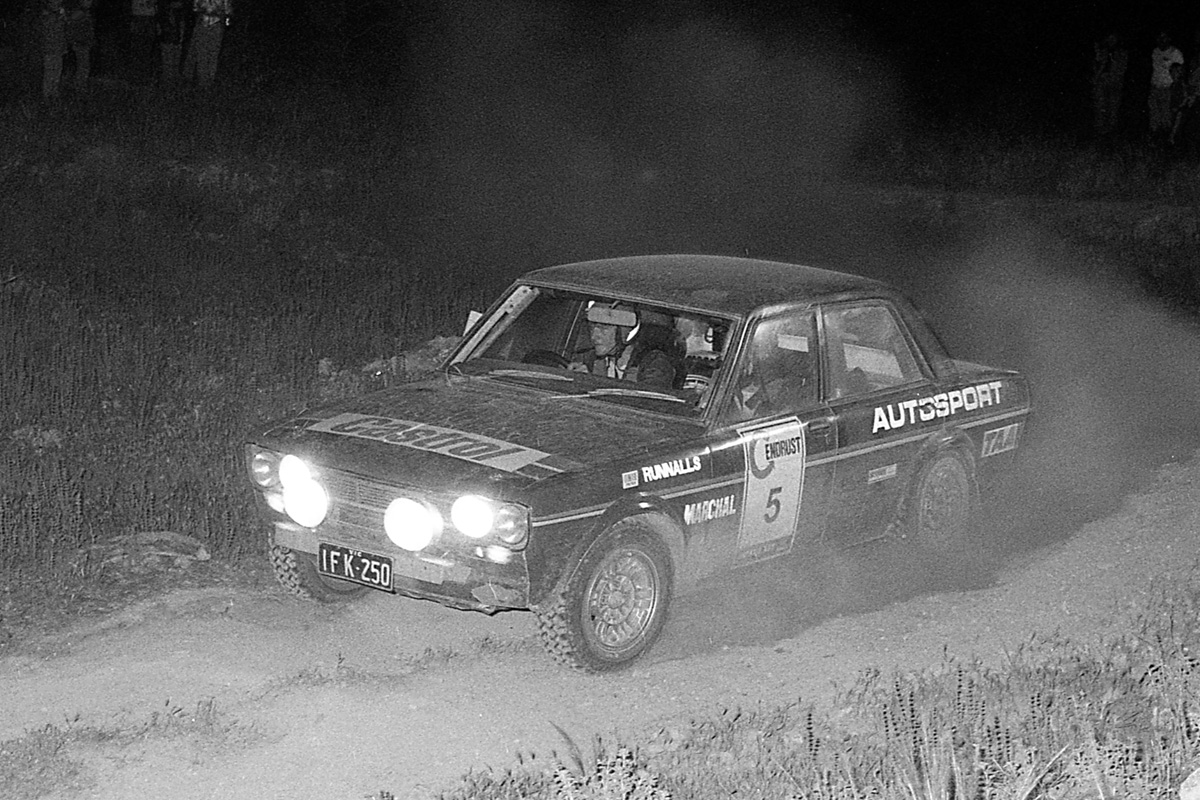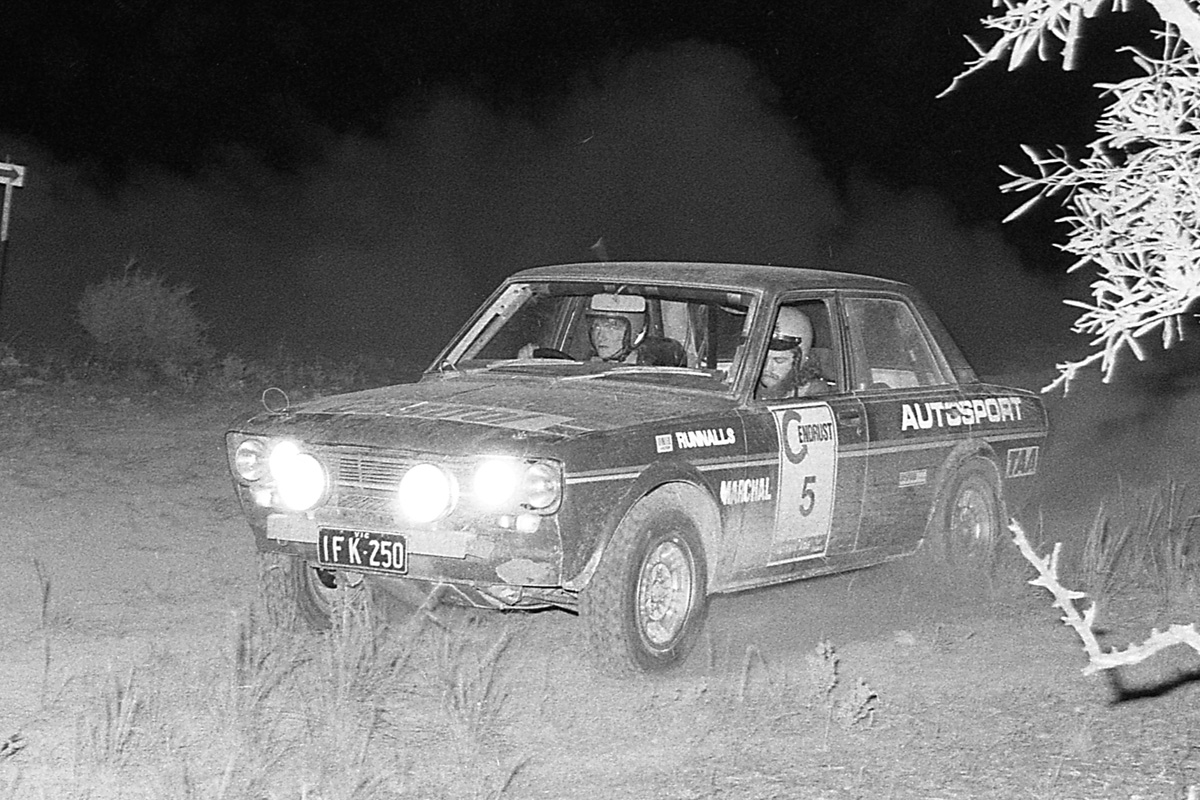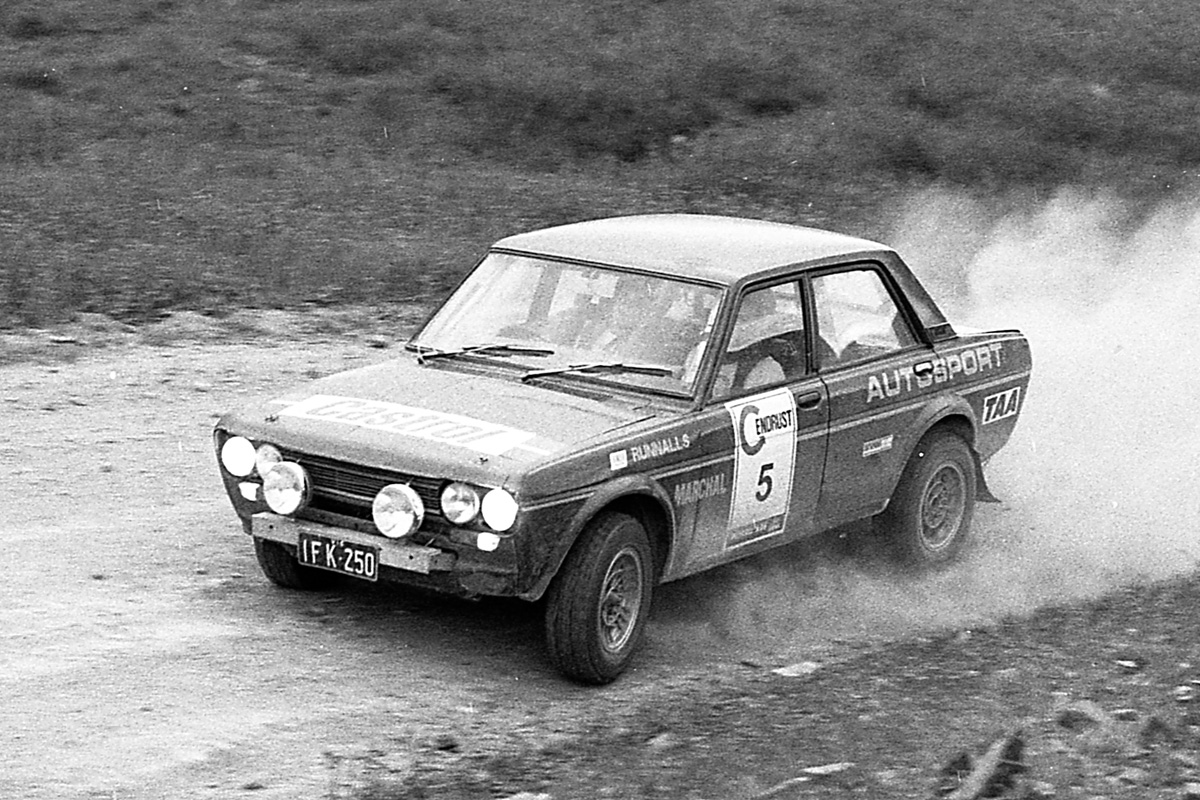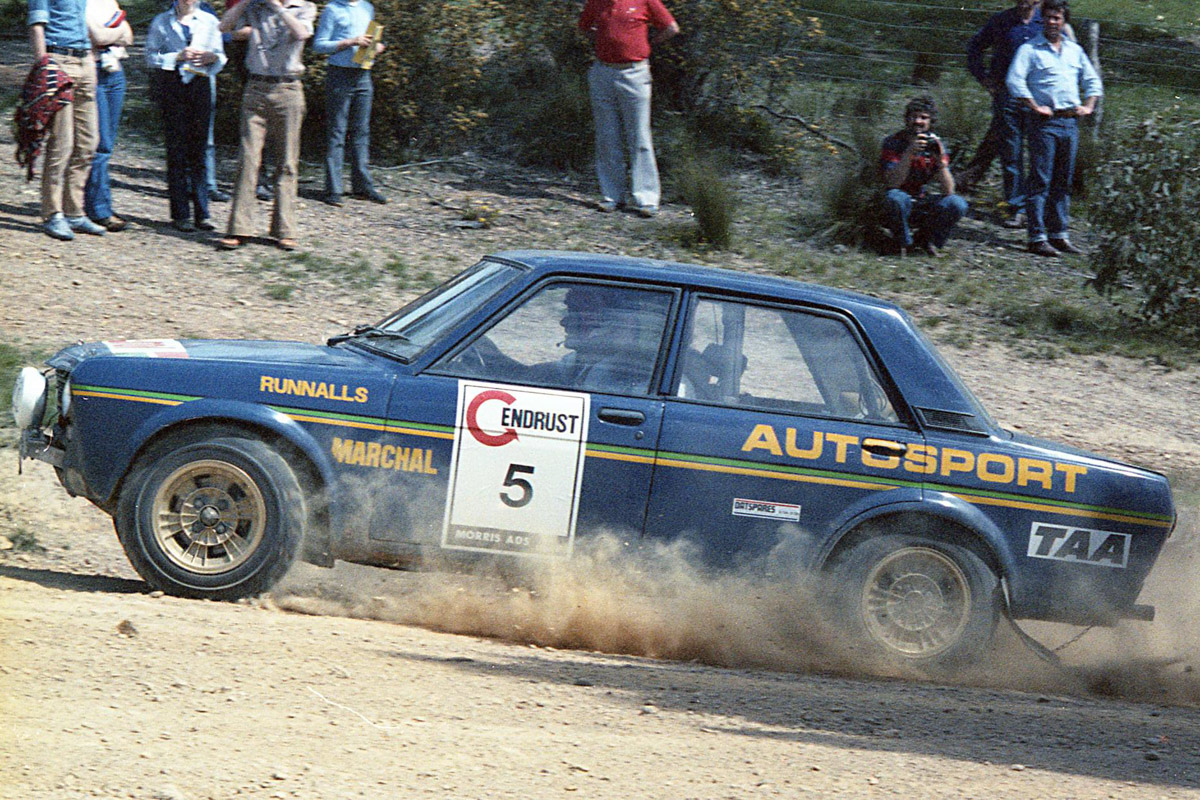
Les Collins takes up the story: “I had hand beaten all the front and rear guards and flared them (to fit the Enkei works wheels and the “Mickey Mouse” Dunlop SP52 tyres) and it had all the running gear from the ’78 Alpine car. By that time we also had refitted the 76 degree cam.
“Derek Rawson (the engine specialist at the Nissan factory team in Braeside) had helped us refresh the engine – the good Japanese ’78 Alpine one. On the Wednesday night prior to the Castrol, I was driving the car from Braeside to Caulfield along North Road in peak hour traffic when the oil light came on.
“That was not good, so we rang Derek, who was at home in Officer at the time, and he agreed to come back to Braeside and have a look at the car for us. Shane Blanford and I flat towed the car back to Braeside. When we got there, Derek had a look and we started it up and well, not so good.
“So we took the engine out and stripped it. We worked all night – again. Everything inside the engine was destroyed. The bearings, the crankshaft, the camshaft, everything.
“We were perplexed. Where had all this damage come from? Luckily, Derek had another camshaft and a set of cam towers, another crankshaft and a set of bearings and we honed the block and put it all back together again.”
But the question still remained, why did it happen? What caused it?
Now, to paint a word picture, a works competition oil cooler line/oil filter adapter used on the 710s is a big aluminium casting which works as a bypass arrangement and fits onto the side of the engine block, with a big bolt and has a couple of check valves in it.
Les explains: “I had very carefully taken this adapter block off the engine and wrapped it up in a plastic bag and tied it up inside the car. I made sure that nothing got into it. But in one of these valves, which is a little steel plate with a hole in it and a spring-loaded ball seating against it, the ball had shattered. This meant that there was a big hole that all the oil was going through without going through the filter. There were a lot of foreign particles in there from the broken ball and when they went through the engine they made a lot more, smaller foreign articles and did lots of damage.

Problems from a lack of sleep
“So we rebuilt the engine and reinstalled it and did about 20 kilometres, then we pulled it apart again and inspected it and rebuilt it again. By this time it was about 5pm on Friday evening. I had had no sleep since Wednesday morning. We took the car back to Caulfield South where the service ute was already loaded. We drove the car onto a trailer and left Trevaskis Street at, I think, 8 o’clock on Friday night.
“And we had to be in Canberra on Saturday morning!
“We got to Benalla and ‘Bess the Ute’ started to have petrol blockage issues, so I rang up one of my mates in Chiltern and said: ‘Adrian we need help!’. So we limped into Chiltern at 11pm – still no sleep – pulled everything out of the Ute, dropped the petrol tank and emptied it and cleaned out the fuel pick up – all in the main street of Chiltern.
“We got it all back together and left about 1 o’clock in the morning. I just could not go any further and I collapsed in the seat and Tom Kaitler drove.
“We arrived in Canberra about 6.30 am, with the Canberra temperature about 1 degree. We started the car up to take it off the trailer and Geoff and Lisa stuck their heads out the door of their unit with huge smiles. They had gone to bed thinking we would not make it. The last time we spoke to them was at Chiltern at about 1 am.
“So we got there and that was the first big event that the real Grunter ever ran.
“There was a stage called ‘Two Sticks’ which had a water crossing in it and Jamie Drummond told me that I had to make sure water did not get on the spark plugs. So I asked him how to do that and he said ‘Just spray them with WD40’. So I did.
“In fact, I was so mentally stuffed that I sprayed all the spark plugs and the caps and the leads with WD40. And what do you think happened? The leads fell off the spark plugs!
“I think Geoff got out of the car three times because I had sprayed the plugs and the leads and the fan just blew them off. He lost a lot of time on that stage and that cost him the rally. He came third in the end. I guess that’s what happens when you are just so tired that you can’t think straight.
“After the Castrol in 1979, we took the engine out and put in 89mm pistons and made it 2.1 litres. That was the first time that anybody acknowledged that a single cam was good for more than 200 bhp. I recall Roger Bonhomme congratulating me, so it must have been a big achievement. Looking back, it was pretty iconic and without doubt, a milestone.”
A works drive for Portman
The other non-ARC or International events for IFK 250 that year was the Chrysler Safari, a VRC round resulting in a DNF after hitting a kangaroo and damaging the radiator (while leading by 6 minutes) and a win in the next VRC roiund, the Begonia Rally, where Wayne Gregson was co-driver.
Following the late September win in the Endrust Rally, it was Alpine time again.
In between the Experts and the Alpine, Geoff had other rallying business to attend to, including the career-defining drive in the Repco Reliability Trial (driving a Stanza built by Shepparton Auto Wreckers) and also a character-building attempt at the Southern Cross International Rally in a Colin Bond-built Repco Reliability Trial Ford Cortina. The Southern Cross effort was again supported by John Armitage.
But back to the 1979 Alpine and Les’s comments.
“In rebuilding the engine for the 1979 Alpine we changed the valves but had to get them made by a fellow in Canterbury, who made valves. He made them from a material called K steel. Unfortunately K steel was the wrong material for our valves, but we did not know that at the time.
“So we put it all together and I drove it to Bright on Friday night to run it in.
“But by the time we got to Bright the car had lost all its power. It would just not go. We tried all sorts of things without resolving the issue. Everyone else just went to bed to prepare for the rally and I continued to try and find out what was causing the mysterious loss of power.”
About 4 o’clock in the morning, after Les had gone through all the obvious issues and ticked off all the boxes, he checked the valve clearances and found some problems. “When checking, I found all the clearances had closed right up.
“I had no idea why that was the case, but once again, with no sleep and loss of concentration, sometimes the brain does not work as it should.
“I did the tappet clearances and adjusted them all up and wow! It went like a rocket!
“So Geoff starts the event and on the third stage, all within a kilometre, three valves failed (the valve heads parted company with the stems) and that was that. Imagine how many cycles all those valves did before they failed and they all failed within a single kilometre.”
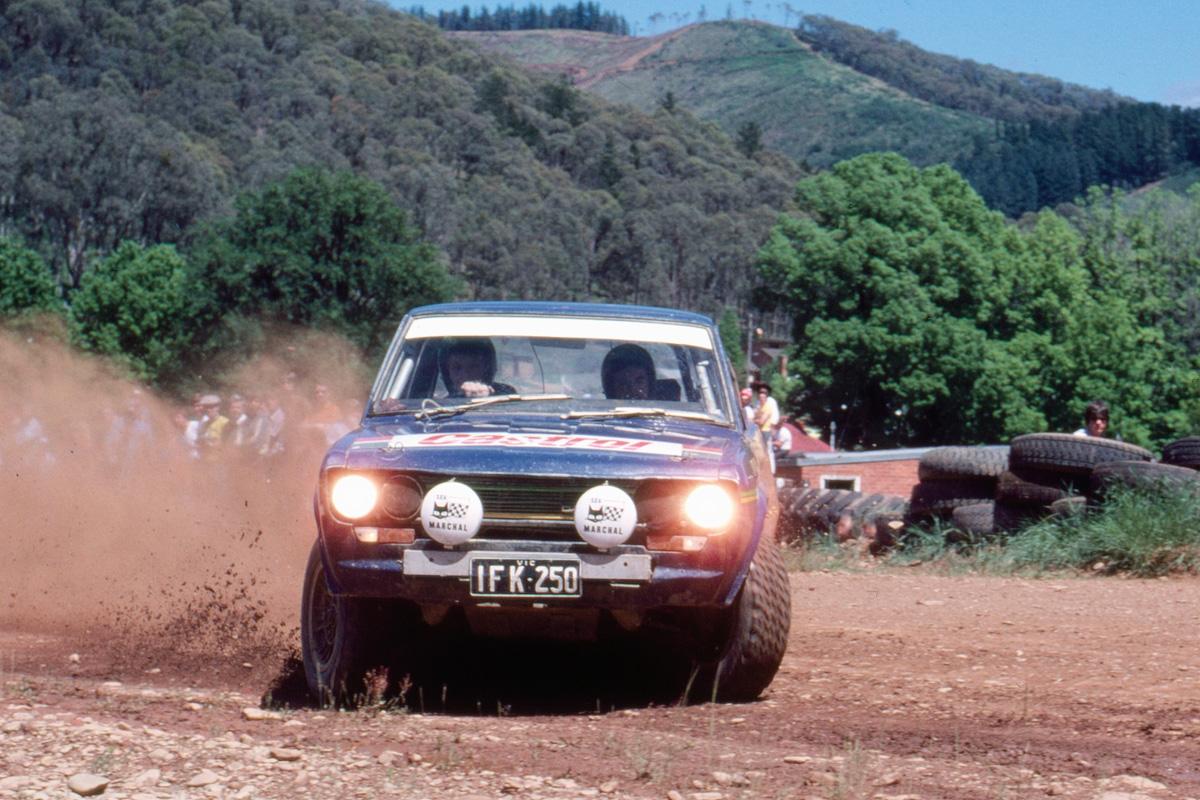
I asked Les if that was heartbreaking for the team? “We were all so laser focused ….” he replied, “I don’t recall a time when a mechanical failure phased Geoff. He always understood and would go to great lengths to mask his disappointment. If we had any sort of a problem with something breaking he really did take that in his stride. Even if we had gone halfway across the country, he took it all on board.”
1980 saw a quiet year for the Grunter, but not so much for Geoff. Grunter was used for selected ARC events and the Alpine, while a number of other machines were to be graced by Geoff’s bum for other events, including a few events as a dinky-di, fully-fledged member of the Datsun Rally Team, driving a works Stanza.
The year kicked off badly for IFK 250 with an eventual DNF early in the Lutwyche Shopping Village Rally, ARC 1 in Queensland. This time it was a blown head gasket which stopped the party. Queensland rallies were not usually kind to IFK 250 and this one was no exception.
Broken parts mean money to repair or replace. Events cost money to run and the Portman team was not exactly flush with the folding stuff. Contrary to popular belief at the time, the assistance from Autosport was not significant in the way of cash – however, it was an absolute gold mine as far as the ability to have access to parts and advice direct from the factory team guys was concerned.
“I don’t know what it was costing him to go to an event, I think we did a few calculations around about that time, and we reckoned that each event (in those days – remember the ARC events were all over Australia) worked out to 8 to 9,000 dollars, which was a bloody lot of money in those days” suggested Twigger.
“Which added up to a fair bit at the end of the year and he (Portman) was always broke. Geoff would take on extra work over summer, including overtime and fire work and the like, to earn some money over the Christmas period and pay off his debts and clear them off, and then he would go and do it again!

The making of ‘The Duck Tail’
“The fact that we did a lot of work on the car that he never had to pay for and that sort of thing I think made a big difference – and with JRA’s help…
“I don’t recall he ever got a lot of cash from anybody as sponsorship. I think a few people got a bit of money… (But) he was constantly broke and in the end it was the death knell of it.”
The 1980 Alpine was the final event of the year. Datsun had only entered one Stanza, for George Fury/Monty Suffern, so the Grunter was brought back to the fore. The Alpine Rally of 1980 will be remembered as being not only wet, but significantly panel damaging for IFK 250!
Wet weather pounded North East Victoria prior to that Alpine and the roads were, at times, like ice rinks. A fact that caught Geoff out and nearly ended the event for him.
When pushing hard on a very slippery right hand corner, Geoff made a rare mistake and hit a bank backwards, which pretty severely squashed the boot (remembering that there was not a great deal of strength in the boot of a 1600, and even less when the spare wheel well is removed), but it pushed it upwards as well! The name “Duck Tail” was soon coined.
Fortunately, most of the damage was cosmetic rather than structural, and Geoff was able to continue. Some quick and handy work was carried out at the afternoon tea break to turn the car into a more roadworthy condition.
In typical never-say-die tradition, Geoff and Ross continued as if nothing was wrong and finished second, behind winner Greg Carr. Colin Bond was third in what would be last event for the works BDA Escorts. The works Datsun Stanza of Fury/Suffern finished in fourth place.
After the 1980 Alpine Rally there needed to be some serious panel beating carried out to right the Alpine wrong, and it was also time for a change of colour, from Autosport blue to white, with green, yellow and blue stripes diagonally across each side, but still sporting Autosport signage. The bonnet was emblazoned with the Datrally name and blue and yellow stripes adorned each front mudguard.
The car looked resplendent. Les’s aim of keeping the original 1600 outline by staying with the original grille went by the wayside and a pair of 7 inch headlights were fitted in place of the 5 ¾ inch Datsun units. The SEV Marchal Starlux IODE 709 driving lights stayed.
In 1981, Geoff was a member of the Datsun Rally Team and drove a factory Stanza in the ARC – missing out only on the first round.
IFK 250 – which was by this time almost universally known as “the Grunter” – would be relegated to selected Victorian trials events. The Victorian Rally Championship that year was won by Geoff in John Armitage’s immaculate Datsun 200B. Geoff and Ross blitzed the Alpine again – and in doing so won the final event that the works Datsun Stanzas would compete in. As a further stamp on his ability, he fairly and squarely beat both his team mates, Ross Dunkerton and George Fury.
Only a few events were run in the Grunter in 1981, but it’s worth remembering that out of the 18 rallies which Geoff entered, he finished first outright in 15. That is a very good batting average!
One event was an Off Road event in NSW, the MacLeay 1000, where Geoff ran with Phil Rainer in the co-drivers seat. The pair started Car 5 and finished sixth outright.
Also driving in that event was George Fury who started Car 2 in a buggy, but he does not get a mention in the top finishers – Geoff believes he “endo-ed” the buggy and that was the end of his event.
Ross Dunkerton started Car 4 in a Stanza (of unknown parentage, but believed to be one of the works cars) and he finished a creditable second outright, sandwiched in the results between between two buggies.
The event was memorable for Geoff, for all the wrong reasons: “We hit a stump on the inside of a corner under some ferns and damaged the front suspension. The wipers stopped and we pushed the windscreen out so we could continue in the rain and mud. It was a shitfully awful wet event,” he recalled.
“Luckily one item we carried ‘just in case’ were motorcycle goggles for Phil and myself. Our rallying was not always as enjoyable as it might appear from various good results.”
Geoff and Ross won three separate championships in 1981; the Australian Rally Championship in the works Stanza; the Victorian Rally Championship in John Armitage’s Datsun 200B SX’ and the Victorian Trials Championship in IFK 250 .
Photos in this feature have been contributed by: Bruce Keys, Dallas Dogger, John Lemm, Ken Cusack, David Balfour, Ray Berghouse/Chevron Publishing, Peter Whitten, Ian Long, Tom Kaitler, B Team Rally Media.






